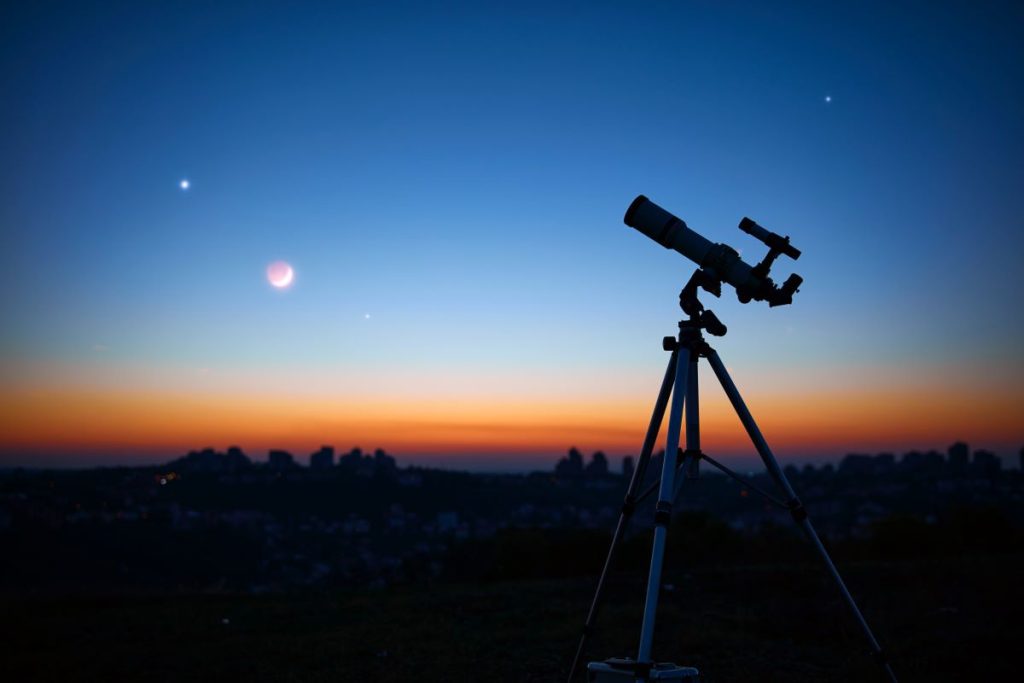Summarize this content to 2000 words in 6 paragraphs January’s long, dark nights always make for special stargazing, but this year our skies are hosting a parade of planets, headlined by Venus, which will shine extraordinarily bright this weekend.Here’s everything you need to catch a glimpse of Venus and the other planets this January.Venus: The Brightest ‘Star’ In the Sky TonightIf you’ve spotted an intensely bright “star” shortly after sunset in the southwestern sky, you’re actually seeing Venus—the second planet from the sun and our closest planetary neighbor.Venus reached a key point in its orbit known as its Greatest Elongation on Thursday night, making it exceptionally visible for the next few evenings. This means it’s currently at its brightest and best for viewing. Venus will remain visible through March, but now is the prime time to catch it in all its glory.
A telescope under a twilight sky ready for stargazing. Venus will shine as one of the brightest objects in the sky, second only to the moon, shortly after sunset this weekend.
A telescope under a twilight sky ready for stargazing. Venus will shine as one of the brightest objects in the sky, second only to the moon, shortly after sunset this weekend.
m-gucci/Getty
To find Venus, look toward the western horizon after sunset. It’s unmistakable as the brightest object in the night sky after the moon. Venus sets around 9:00 p.m. (ET and PT), so you don’t need to wait up late.What is Venus’ Greatest Elongation?The greatest elongation refers to the point when Mercury or Venus appears farthest from the sun in the sky’s dome. This phenomenon provides the best opportunity to observe these inner planets without interference from the sun’s glare.”At the moment, Venus is at its greatest elongation east, making it further away from the Sun in the sky than at any other time in the year,” Jake Foster, public astronomy officer at the Royal Observatory Greenwich, told Newsweek.”This means that it’s a great time to observe Venus, as it is shining brightly in the evening sky long after the Sun has set.”According to Stellarium, Venus will have a magnitude of -4.32 on Friday night, making it almost 14 times brighter than Sirius, the brightest star in the sky.During this elongation, Venus is at a maximum separation of 47.2 degrees from the sun—its largest elongation of the year, according to EarthSky.What is the Bright Star Under the Moon Tonight?Venus isn’t the only planetary gem lighting up the night sky this January. Look for a bright object near the moon over the next few nights—that’s Jupiter.With a magnitude of -2.53, Jupiter is slightly dimmer than Venus but still brighter than any actual star in the sky.Jupiter is located between the constellation Orion, known for its iconic belt of three stars, and the moon.If you have access to a telescope, take a closer look at Jupiter to spot its four largest moons: Callisto, Europa, Ganymede and Io.What Other Planets Are Visible Tonight?January is a treasure trove for planetary enthusiasts, offering an extraordinary chance to view multiple planets.Saturn, the famous ringed planet, is currently visible just above and to the left of Venus. The two planets will appear to draw closer to each other until January 17, when they’ll appear to cross paths in the sky.”Saturn can also be seen close by as a slightly fainter white dot, while Jupiter and Mars can be seen further east following a similar path across the sky,” Foster said.Together, these four planets—Venus, Saturn, Jupiter, and Mars—are part of a planetary parade that will continue throughout January. Uranus and Neptune, while much harder to see, are also part of this lineup.By the end of February, Saturn will be obscured by the glare of the sun. But as one planet leaves the parade, another will join, with Mercury making an appearance by the end of February.Do you have a tip on a science story that Newsweek should be covering? Do you have a question about Venus or other planets? Let us know via science@newsweek.com.


